
The World Cinema Project (WCP) preserves and restores neglected films from around the world. To date, 64 films from Africa, Asia, Eastern Europe, Central America, South America, and the Middle East have been restored, preserved and exhibited for a global audience. The WCP also supports educational programs, including Restoration Film Schools; intensive, results-oriented workshops allowing students and professionals worldwide to learn the art and science of film restoration and preservation. All WCP titles are available for exhibition rental by clicking "Book This Film."

TREASURE, THE
NIDHANAYA
Director: Lester James Peries
WRITTEN BY: Tissa Abeysekera
EDITING: Lester James Peries, Edwin Leetin, Gladwyn Fernando
DIRECTOR OF PHOTOGRAPHY: M.S. Anandan
ADAPTED BY: G. B. Senanayake
MUSICAL DIRECTOR: Premasiri Khemadasa
ART DIRECTOR: J.A. Vincent Perera
STARRING: Gamini Fonseka, Malani Fonseka, Saman Bokalawala, Francis Perera, Mapa Gunaratne, Shanthi Lekha, Trilicia Gunawardene, Thilakasiri Fernando, J.B.L. Fernando, Thalatha Gunasekera, Kumarasinghe Appuhamy, K.L. Coranelis Appuhamy, Barry Whittington, Wijeratne Warakagoda
COUNTRY OF PRODUCTION: Sri Lanka
LANGUAGE: Sinhala
COLOR INFO: Black and White
RUNNING TIME: 108 minutes
PRODUCTION COMPANY: P.E.E. Anthonypillai for Ceylon Studios
Restored in 2013 by Cineteca di Bologna/L'Immagine Ritrovata laboratory, in association with The Film Foundation’s World Cinema Project, Lester James and Sumitra Peries, the National Film Archive of India, the National Film Corporation of Sri Lanka, Cinemas Ltd. Additional restoration elements provided by Degeto Films. Restoration funded by Doha Film Institute.
Nidhanaya is based on a dark tale by G.B. Senanayake and is considered a milestone film that people, even abroad, admire the most, albeit it is atypical of Lester James Peries’ customary family dramas. The story revolves around a psychotic killer yet is an underlying serious political study on the degradation of a class of society. In 1972 this film won the Silver Lion of St Mark at the 33th Venice International Film Festival and was selected as one of the outstanding films of the year, receiving a Diploma at the London Film Festival. It was also voted as the best film of the first 50 years of Sri Lankan cinema.
My most controversial film is Nidhanaya, which received a very positive reception at the Venice Film Festival. The most accurate critics highlighted that, despite its setting in 1911, this film holds a strong social and political value in denouncing the system. The character is trapped between two cultures: the Western/British one and his culture of origin—he is lost between two worlds. Unable to adapt to either one or the other, he absorbs the worse elements of the two cultures; the society changes and he goes insane.
- Lester James Peries
NOTES ON THE RESTORATION:
The restoration of Nidhanaya was made possible through the use of two key elements: a 35mm positive print struck from the original camera negative and held by Degeto Film, and a combined dupe negative preserved at the National Film Archive of India.
The prints were scanned at 4K resolution. After scanning, the image was stabilized and cleaned, and all wear marks were eliminated. Image grading recovered the richness of the original cinematography. The soundtrack was also digitally cleaned and background noise reduction was applied to reduce imperfections without losing the dynamic features of the original. The digital restoration produced a new 35mm internegative.
The World Cinema Foundation would like to thank the following individuals and organizations for their support: G R Padmaraj and Cinemas Ltd, National Film Corporation of Sri Lanka, National Film Archive of India, Shivendra Singh Dungarpur, Ravindra and Sam Randeniya, and Hubert Niogret.
Special thanks to Lester James Peries and Sumitra Peries for facilitating the restoration process.
Image: © Courtesy of National Film Corporation of Sri Lanka

TWO GIRLS ON THE STREET
KÉT LÁNY AZ UTCÁN
Director: André De Toth
WRITTEN BY: Tamás Emod, Rezsö Török
EDITING: Zoltán Kerényi
DIRECTOR OF PHOTOGRAPHY: Károly Vass
ADAPTED BY: André De Toth
PRODUCER: Béla Lévay
FROM: Hungarian National Film Archive
PRODUCTION DESIGN: Gizella Langermann
STARRING: Bella Bordy (Torma Vica), Mária Tasnádi Fekete (Kártély Gyöngyi), Piroska Vaszary Pletyus (as Vaszary Piri), Gyula Csortos (Filc bácsi), Andor Ajtay, Csiszár István, Károly Kovács, Lali
COUNTRY OF PRODUCTION: Hungary
LANGUAGE: Hungarian with French and English subtitles
COLOR INFO: Black and White
RUNNING TIME: 85 minutes
PRODUCTION COMPANY: Hunnia Filmgyár
PRODUCER: Béla Lévay
Restored in 2010 by Cineteca di Bologna/L'Immagine Ritrovata laboratory, in association with The Film Foundation’s World Cinema Project and Magyar Nemzeti Filmarchívum. Restoration funded by Armani, Cartier, Qatar Airways and Qatar Museum Authority.
André De Toth was a great filmmaker, we are indebted to him for a number of extraordinary films (dating back to his first Hungarian works) and many masterpieces. He fought to make ambitious films and refused to work under a studio contract, thus showing a rare desire for freedom […] One day, following a screening of Round Midnight, De Toth told me, “You made me cry. And it’s hard to cry when you only have one eye.” He comforted and supported me. He was never bitter, he would never have said something like: “Cinema was better when I was making films”. He remained curious, open-minded; he battled for the American Cinematheque on Hollywood Boulevard […] “We’re like passengers driving at full speed on the new highways of communication”, he wrote. “It’s the same road since 1895, only it’s slippier because of the sweat and the blood and with more cracks: each of them a broken dream. These past hundred years have been terrible, yet we’ve enjoyed every single minute of them. As long as this fever, this love for making films survives, nothing will ever change.” On his sets, one big sign read, “Drama should occur in front of the camera, not behind it”, another, “Technology will never replace brains and intelligence”.
(Bertrand Tavernier)
NOTES ON THE RESTORATION:
The restoration of Két Lány Az Utcán used the original 35mm camera and sound nitrate negatives preserved at the Magyar Nemzeti Filmarchívum (Hungarian National Film Archive). The digital restoration produced a new 35mm internegative.
Image: © Courtesy of Magyar Nemzeti Filmarchívum (Hungarian National Film Archive)

VOYAGE AUX ANTILLES DU PRÉSIDENT SENGHOR
Director: Georges Caristan
COUNTRY OF PRODUCTION: Senegal
LANGUAGE: French with English subtitles
COLOR INFO: Black and White
RUNNING TIME: 17 minutes
Restored by The Film Foundation’s World Cinema Project and Cineteca di Bologna at L’Immagine Ritrovata laboratory, in collaboration with the Ministère de la Culture et du Patrimoine Historique de Sénégal – Direction du Cinéma. Restoration funded by the Hobson/Lucas Family Foundation.
This restoration is part of the African Film Heritage Project, an initiative created by The Film Foundation's World Cinema Project, the Pan African Federation of Filmmakers and UNESCO―in collaboration with Cineteca di Bologna―to help locate, restore, and disseminate African cinema.
NOTES ON THE RESTORATION:
The 4K restoration was completed using a 16mm print preserved by the Direction du Cinéma in Senegal. With special thanks to Tiziana Manfredi and Marco Lena.

YAM DAABO
Director: Idrissa Ouédraogo
WRITTEN BY: Idrissa Ouédraogo
EDITING: Arnaud Blin
DIRECTOR OF PHOTOGRAPHY: Jean Monsigny
STARRING: Moussa Blogo, Aoua Guiraud, Assita Ouedrago, Fatima Ouedrago, Omar Ouedrago, Salif Ouedrago , Rasmané Ouedraogo
COUNTRY OF PRODUCTION: Burkina Faso
COLOR INFO: Color
RUNNING TIME: 80 minutes
Restored by The Film Foundation’s World Cinema Project and Cineteca di Bologna at L’Immagine Ritrovata laboratory, in collaboration with Les Films de la Plaine and the family of Idrissa Ouédraogo.
Restoration funded by the Hobson/Lucas Family Foundation.
This restoration is part of the African Film Heritage Project, an initiative created by The Film Foundation's World Cinema Project, the Pan African Federation of Filmmakers and UNESCO―in collaboration with Cineteca di Bologna―to help locate, restore, and disseminate African cinema.
NOTES ON THE RESTORATION:
YAM DAABO was restored in 4K using the 16mm original camera negative and magnetic sound. Color grading was finalized with the help of director of photography Sekou Ouedraogo.
